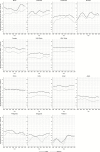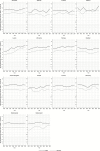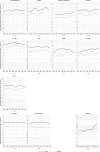Cancers of the brain and CNS: global patterns and trends in incidence
- PMID: 27571887
- PMCID: PMC5464292
- DOI: 10.1093/neuonc/now166
Cancers of the brain and CNS: global patterns and trends in incidence
Abstract
Background: Cancers of the brain and CNS constitute a group of rare and heterogeneous tumors. Increasing incidence in Western populations has been linked to improvements in diagnostic technology, although interpretation is hampered by changes in diagnosis and reporting. The present study examines geographic and temporal variations in incidence rates of brain and CNS cancers worldwide.
Methods: Data from successive volumes of Cancer Incidence in Five Continents were used, including 96 registries in 39 countries. We used Joinpoint regression to estimate the average annual percentage change and its 95% CI.
Results: Globally, a large variability in the magnitude of the diagnosis of new cases of brain and CNS cancer was found, with a 5-fold difference between the highest rates (mainly in Europe) and the lowest (mainly in Asia). Increasing rates of brain and CNS cancer were found in South America, namely in Ecuador, Brazil, and Colombia; in eastern Europe (Czech Republic and Russia), in southern Europe (Slovenia), and in the 3 Baltic countries. Trends were similar between sexes, although decreasing trends in men and women were seen in Japan and New Zealand.
Conclusions: Important regional variations in brain and CNS cancers exist, and given an increasing burden and risk worldwide, there is a need for further etiological research that focuses on the elucidation of environmental risk. The trends are sufficiently complex and diffuse, however, to warrant a cautious approach to interpretation.
Keywords: brain and CNS tumors; cancer registries; epidemiology; incidence; time trends.
© The Author(s) 2016. Published by Oxford University Press on behalf of the Society for Neuro-Oncology. All rights reserved. For permissions, please e-mail: journals.permissions@oup.com.
Figures





References
-
- Louis DN, Perry A, Reifenberger G, et al. The 2016 World Health Organization Classification of Tumors of the Central Nervous System: a summary. Acta Neuropathol. 2016;131(6):803–2. - PubMed
-
- Ferlay J, Seorjomataram I, Ervik M, et al. GLOBOCAN 2012 v1.0, Cancer Incidence and Mortality Worldwide: IARC CancerBase No. 11 [Internet]. Lyon, France: International Agency for Research on Cancer; 2013. Available from: http://globocan.iarc.fr. Accessed May 30, 2016.
-
- Ohgaki H. Epidemiology of brain tumors. Methods Mol Biol Clifton NJ. 2009;472:323–342. doi:10.1007/978-1-60327-492-0_14. - PubMed
-
- Fisher JL, Schwartzbaum JA, Wrensch M, et al. Epidemiology of Brain Tumors. Neurol Clin. 2007;25(4):867–890. - PubMed
-
- Ho VKY, Reijneveld JC, Enting RH, et al. Changing incidence and improved survival of gliomas. Eur J Cancer Oxf Engl 1990. 2014;50(13):2309–2318. - PubMed
MeSH terms
Grants and funding
LinkOut - more resources
Full Text Sources
Other Literature Sources
Medical

